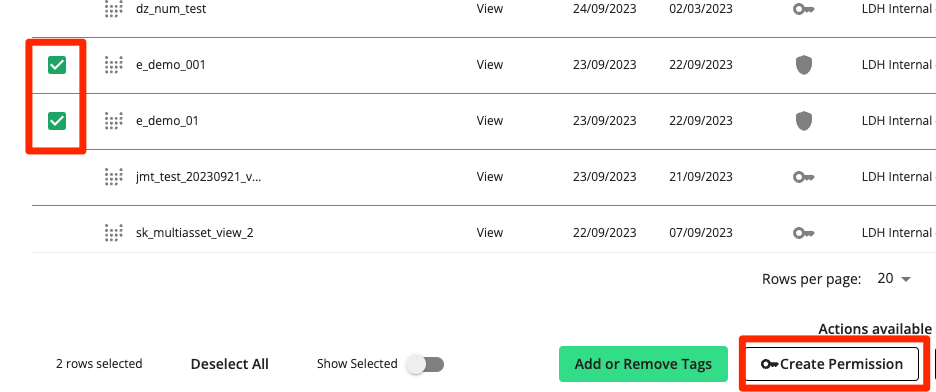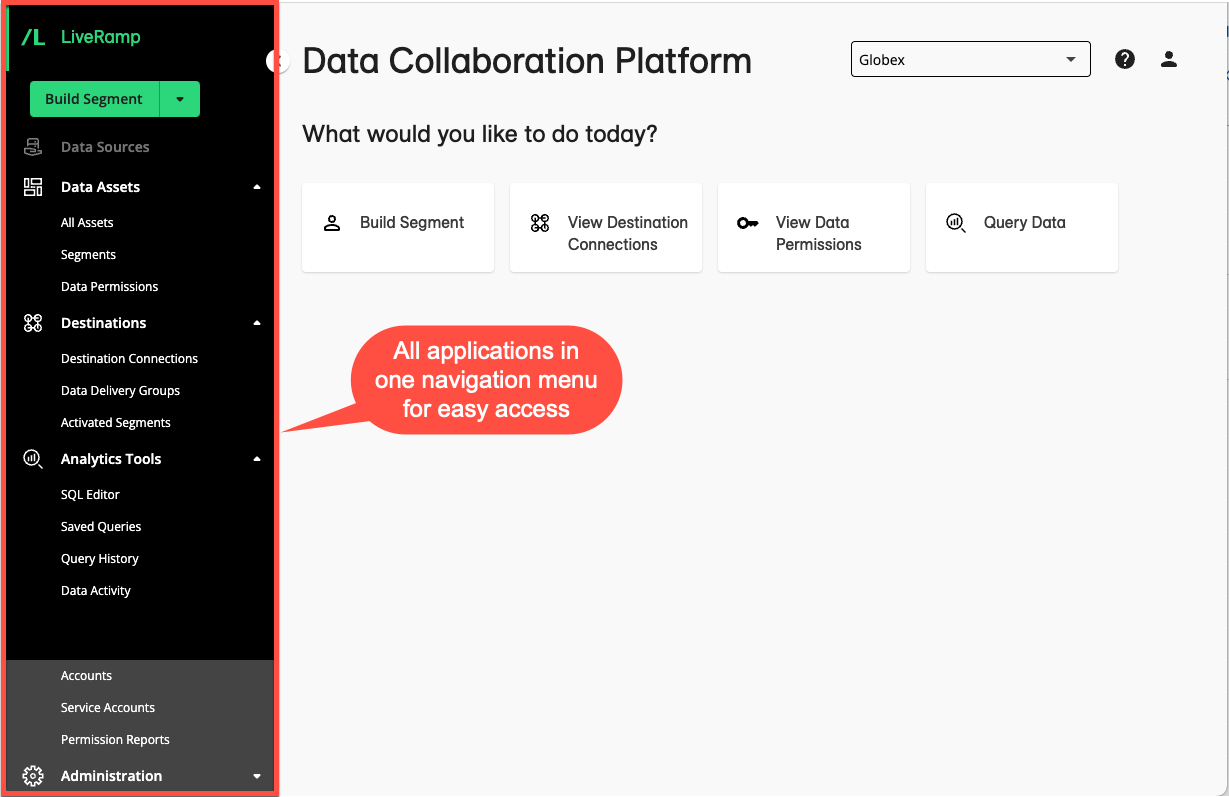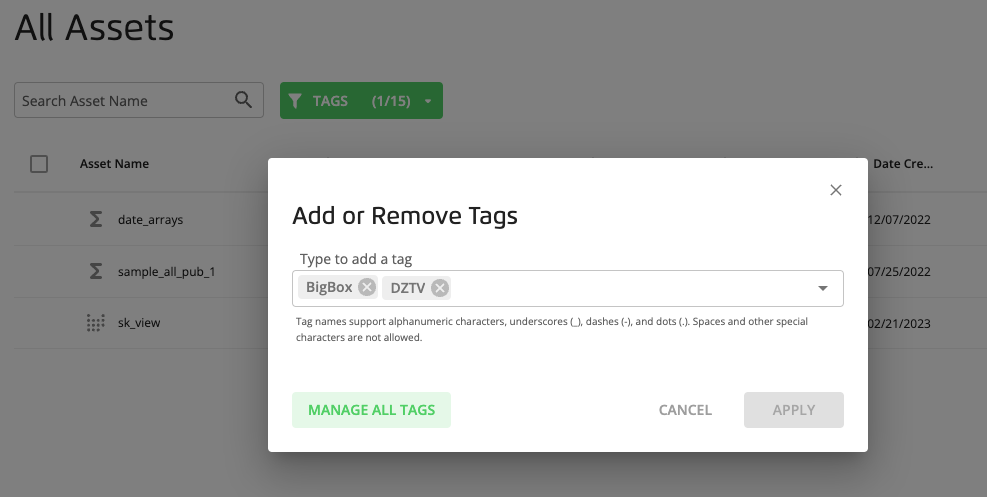Product Updates and Announcements
This section contains information on product updates and other changes that might affect LiveRamp customers.
July 17, 2025 - User-Configured Data Quality Gates
Identity Engine users can now configure data quality gates to further ensure the accuracy of their first-party graph. These user-configurable gates provide process-level checks of the data preparation, resolution, and export processes of a workflow. The data quality gates can identify issues, stop the workflow at any stage needing further review, and provide an error message in the process indicating any data quality problems.
To learn more about configuring Identity Engine data quality gates, see "Data Quality Gates", “Configure a Data Preparation Process”, “Configure a Resolution Process”, and “Configure an Export Process”.
May 8, 2025 - Required Updates for LiveRamp's Public Encryption Key
LiveRamp takes data security very seriously, and we are constantly looking for ways to improve. One of the ways we keep data secure is through file encryption using our public encryption key. This encryption key allows you to encrypt your data before sending it to LiveRamp. We update our encryption keys every two years in accordance with security best practices.
We updated our public encryption key on May 8, 2025. You can begin using this key to encrypt files now.
If you encrypt the files you send to LiveRamp, make sure to update to the new encryption key before July 2, 2025, and make sure that all teams that are encrypting files are using the updated key. To download the new key, click here (or see "Encrypting Files for Uploading").
Starting on July 2, only the new encryption key can be used and the file upload will fail if you try to upload a file encrypted with a previous encryption key (the ingestion status shown on the Files page will show "Processing Failed" and display a message that the incorrect encryption subkey was used).
Once you have successfully updated your encryption key, you will be able to encrypt your files as you would normally.
Note
While you can continue to use the previous key to encrypt files up until July 2, we recommend updating to the new key as soon as possible to make sure the update is in place before the deadline.
Once you've updated the key, you can validate that you're using the new encryption key by running the following command on an encrypted file from your gpg software:
gpg --list-packets [filename]If the correct encryption key was used, you will see
ID 26598156F2C8792Din the response.
If you have any questions, contact your LiveRamp representative.
April 24, 2025 - Super User Is Now Super User - Admin
To align terminology and user experience across LiveRamp products, we have renamed the Super User role in the Data Collaboration Platform to Super User - Admin. We implemented this change to create a more consistent experience for users who interact with Connect and the Data Collaboration Platform, where the permissions granted by the Admin and Super User roles are equivalent across the two platforms.
No action is required from you regarding this change.
To learn more about roles in the Data Collaboration Platform see "Roles and Permissions".
April 21, 2025 - Identity Engine Graph Metrics Dashboard
To support Identity Engine graph lifecycle management and value realization, you can now view key metrics for your graph builds. The Identity Engine graph metrics dashboard provides a clear visual display of important graph metrics, including:
Enterprise IDs
Customer IDs
Consolidation rates
Fill rates
Customer IDs to Enterprise ID distribution
The dashboard provides an overview of the graph build and separate tabs for trends over time in the graph-building process, offering insights into:
Data Preparation
Resolution
Export
To learn more, see “Graph Build Overview,” “Data Preparation Trends,” “Resolution Trends,” and “Export Trends.”

November 22, 2024 - Delete Assets and Manage Deleted Assets in Recycle Bin
You can delete assets (segments, tables, views, and UDFs) from any Data Catalog page and manage deleted tables, views, and segments in the Recycle Bin. Deleted tables, views, and segments can be restored within 30 days of deletion and are permanently deleted from the Recycle Bin after 30 days. To learn more, see “Delete an Asset” and “The Recycle Bin Page”.

October 24, 2024 - View Asset Details and Activity History
You can now view all details regarding an asset in full-page view and view the activity history of a specific asset.
The Asset Details Page
The Asset Details page provides a full-page view of asset information and a shareable URL to direct others to that asset. You can also perform various actions on this page such as creating a data permission, adding or removing tags, and inserting the asset in SQL Editor.
To go to the Asset Details page, select All Assets from the navigation pane, and double-click on a row of an asset. To learn more, see "View Asset Details".
The Activity History Tab
You can now track changes and view historical logs of actions taken on a specific asset in the Activity History tab. This tab lists all the changes to an asset such as when the last time an asset was updated, when the data was last refreshed, any permission updates, and other relevant changes.
To go to the Activity History tab, open the side panel tab of an asset and select Activity History. To learn more, see "The All Assets Page".
September 20, 2024 - Ownership Column in Pages Listing Assets
The "Data Type" column in pages listing assets (segments, tables, views, and user-defined functions) has been renamed "Ownership" to indicate the ownership of an asset as follows:
 My Data (first-party data)
My Data (first-party data) Partner Data (second-party data)
Partner Data (second-party data)
To learn more, see "The All Assets Page" and "The Segments Page".
September 4, 2024 - Workflow Execution Status Page
The new Workflow Execution Status Page lets you view the status of a workflow and the connections and status of each process in the workflow. This can help confirm successful execution of a workflow or troubleshoot problems by displaying the status of each process in the workflow.
You can do the following on the Workflow Execution Status page:
Select and view workflows that have run and the status of each.
View and adjust a workflow run schedule.
View the connections and status of each process in a workflow.
View logs of successful or failed processes in a workflow.

August 19, 2024 - Download and Upload Workflows and Processes in Identity Engine
You can now download configured workflows and processes as JSON files and upload them to re-apply the same configuration. This enhancement will save you time when creating multiple workflows and processes with the same configurations in Identity Engine.
Download and Upload Workflows
You can download existing workflows and upload them only to new (blank) workflows. When you upload a workflow, all processes and their settings will be pre-configured on the Workflow Editor page where you can optionally modify your uploaded workflow.
To download or upload a workflow, go to the Workflow Editor page and select → or .
Download and Upload Processes
You can download a process only after it has been configured, which is indicated by the absence of the yellow warning icon  . You can then upload the file to configured and non-configured processes of the same type. For example, a JSON file for a resolution process can only be uploaded to another resolution process.
. You can then upload the file to configured and non-configured processes of the same type. For example, a JSON file for a resolution process can only be uploaded to another resolution process.
Uploading a process will allow all fields and options to be predefined, which you can modify or leave as is.
To download or upload a process, go to the Workflow Editor and click the three dots icon (or the yellow warning icon  ) on a desired process. Select or .
) on a desired process. Select or .
August 2, 2024 - Improved Search Functionality for Assets
We have improved the way our search functionality works when searching for data assets. This improvement allows you to search for assets more efficiently and intuitively while yielding more accurate results.
Some of the enhancements include:
Partial match search which allows the use of incomplete terms to find assets
Underscores are now ignored
Ability to match words in any order
Results displayed based on relevance
Wildcards support by using * to replace parts of the asset’s name. For example: type ‘*male’ to see assets which names end with ‘male’.
This improvement is applied to the search functionalities on the following pages and dialogs:
June 27, 2024 - Add Multiple Accounts Simultaneously
Users with the Super User or User Manager role can now add multiple user and service accounts at the same time. You can add a maximum of 10 accounts simultaneously with the same roles. Note that you cannot add multiple accounts and grant them different roles at the same time.
Tip
To see your roles, click the user icon on the top right-hand side of any screen and select My Profile.
To add accounts, go to and click . Separate each email address or service account name with a comma, [Space], or [Enter]. To learn more, see "Add Accounts with Roles".
January 17, 2024
Receive and Manage Notifications
You can manage personal in-app and email notifications for certain events in your organization in the Data Collaboration Platform. This enhancement allows you to select activities of interest in your organization you want to be notified of so you can take action.
To start configuring notifications, go to . To learn more, see Manage and View Notifications.

Creating Multiple Data Permissions
You can create multiple data permissions simultaneously for the same data partner. This helps you save time if you intend to share multiple data assets with the same configuration for a partner. Multiple permissions may be created for the following data assets.
Multiple tables
Multiple views
Multiple UDFs
Multiple tables and views
To create multiple data permissions, go to → , select the check boxes of the assets you want to create data permissions for and click .

To learn more, see Create a Data Permission.
December 13, 2023 - Creating Views
You can create a view using a CREATE OR REPLACE VIEW statement. SQL Editor's button was removed.
New views are displayed under the "Views" node in SQL Editor's All Assets pane. Previously created views continue to be displayed under their table name.
Any views available to you that are hosted on another data warehouse are grouped in the All Assets pane under a name that was specified in its data warehouse.
August 16, 2023 - Navigation Pane Updates
This release provides streamlined navigation and prepares the Data Collaboration Platform for additional applications.

Key changes to the navigation include:
Fewer clicks because options for all applications are in one navigation pane.
New section categories:
Data Sources: Reserved for future applications.
Data Assets: Includes pages for all your data assets and data permissions.
Destinations: Includes all your data distribution pages, including Destination Connections, Data Delivery Groups, and Activated Segments.
Analytics Tools: Includes all SQL Editor applications, such as Saved Queries, Query History, and Data Activity.
Administration: Includes all administrator applications, including Accounts, Service Accounts, and Permission Reports.
The following navigation pane options were moved or renamed and some application pages were renamed:
Prior Option Location | New Location |
|---|---|
→ → | → |
→ → | → |
→ → | → |
→ → | → |
→ → | → The Download Activity Reports page will soon be renamed to Permission Reports because reviewing data activity is considered an admin user task. |
→ → | This button also includes the following additional actions: |
→ → | → |
→ → | → |
→ → | → The Permissions page was renamed "Data Permissions". |
→ → | → The Integration Connections page was renamed "Destination Connections". |
→ → | → This button was combined with the persistent button. |
→ → | → The Activation Bundles page was renamed "Data Delivery Groups". |
→ → | → The Active Segments page was renamed "Activated Segments". |
→ → | → This button was combined with the persistent button. |
August 1, 2023
SQL Editor supports the approx_percentile and percentile_approx SQL functions. For information, see "SQL Functions".
July 12, 2023 - Data Activity
If you specify query statement visibility rules when you create a permission for a table or a view, your partners' queries (if any) will be displayed on the Data Activity page when you click the corresponding entrird. For information, see "The Data Activity Page".
July 6, 2023 - Improvements to Search for Documentation Sites
We've released a new search for our help documentation sites so that you can find the help articles you need more quickly and easily. New features include:
Faster search: Search results begin to appear as soon as you’ve entered 3 characters, resulting in a faster search and giving you the ability to quickly adjust your search if it isn’t returning your desired results
Better search performance: Your desired result should appear closer to the top of the results most of the time
Better results display: The highlighting of the search string in the results has been improved
Better data: We can access improved analytics, so we can continue to improve your search experience
The new search displays results as you type (once you've entered at least three characters).

You can either click on the result you want or press Enter to be taken to a dedicated search page showing your search results.

Tip
To modify the search string on the dedicated search page, type in the search bar and then press "Enter".
We hope this improved search helps you get the information you need.
Note
This release will also enable us to add more features in the future to continue to improve your ability to search our help articles.
If you have any search feedback, email documentation-feedback@liveramp.com or click one of the "Was this helpful?" links at the bottom of any article.
June 21, 2023 - Data Activity Report
The Data Activity report download includes changes to the following columns:
Referenced Columns: This new column contains information about the columns that users queried. This information was previously included in the "SQL" column
SQL: This column now includes users' SQL queries.
If you lack the data visibility permissions for the data assets, the corresponding cells are left blank in the report.
June 14, 2023
Data Activity
If you have permission to view query results and they have been performed within the last two weeks, you can access them on the Activity Detail side panel on the Data Activity page. Otherwise, the button is disabled.

Download Query Results and UDF Dashboard as CSV
From SQL Editor's Results section, you can select the option.

May 10, 2023
We've upgraded our user interface design to better support other LiveRamp data collaboration capabilities, allowing for additional features and integrations in the future.
SQL Editor supports the where clause for cross joins. For example:
SELECT COUNT(*) FROM pub1 CROSS JOIN pub1_small WHERE pub1.campaign_id != pub1_small.campaign_id
May 5, 2023 - UDF Query Visibility
The Create Permission dialog includes options for setting query visibility for a user-defined function:
Query Visibility: If you select this option, your partner's SQL queries will be displayed on the Data Activity page. Your partner will be notified that you can view their queries when they select this UDF in SQL Editor.
UDF Visibility: If you select this option, your partner can view the underlying SQL statement that you used to create this user-defined function. They can see it on the UDF's side panel on their All Assets page.
For information, see "Create a Data Permission".
April 26, 2023
To be more inclusive of other solutions beyond data collaboration, this application is now called "LiveRamp" instead of "Data Hub".
April 24, 2023 - SQL Editor Enhancements
SQL Editor supports the following set operators:
SELECT COUNT(rampid) FROM ( SELECT rampid FROM table1 INTERSECT SELECT rampid FROM table2 EXCEPT SELECT rampid FROM table3 )
SQL Editor supports window functions without partitioning. For example:
SELECT ROW_NUMBER(ORDER BY rampid), ad FROM table1
SQL Editor supports transcoded joins for more than two tables, which can be useful when working with RampIDs. For example:
SELECT COUNT(*) FROM table1 t1 INNER JOIN table2 t1 ON (t1.rampid = t2.rampid) INNER JOIN table3 t3 ON (t1.rampid = t3.rampid)
March 15, 2023 - Asset Tag Management
You can add your own custom tags to your data assets to categorize them. This can help you to search, filter, and sort your assets.

For information, see "Manage Asset Tags".
March 14, 2023
SQL Editor supports a parameter "hint" syntax that provides UDF users with suggested parameter values when viewing a UDF dashboard. For example:
-- @hint {"input_campaign_id": {"one_of": [12345, 56789, 15325]},
-- "campaign_start_date": {"range": ['2022-01-01', '2022-05-01'] },
-- "campaign_end_date": {"range": ['2022-02-01', '2022-06-01'] },
-- "conversion_windows_days": {"range": [1, 14] },
-- "device_types": {"any_of": ["mobile", "web", "tv"] }
-- }
CREATE OR REPLACE FUNCTION attributed_conversions_by_campaign(
input_campaign_id string,
campaign_start_date date,
campaign_end_date date,
conversion_windows_days integer,
device_types array<string>
) as select CONCAT(input_campaign_id, campaign_start_date, campaign_end_date, conversion_windows_days, ARRAY_JOIN(device_types, '')) as resFor information, see "Including Suggested Parameter Values in UDFs".
March 10, 2023 - New URL for the Data Collaboration Platform Documentation
LiveRamp's Data Collaboration Platform documentation has moved from Safe Haven help to the following URL:
https://docs.liveramp.com/app/index.html
This allows you to browse and search only for Data Collaboration Platform topics. For information about using this documentation, see "Tips for Using This Documentation Site".
November 11, 2022 - Permissions Enhancement
You can select the column to use for query threshold aggregation in the Collaboration Rules step of the Create Permission dialog (household ID, RampID, or select another column). For information, see "Create a Data Permission".